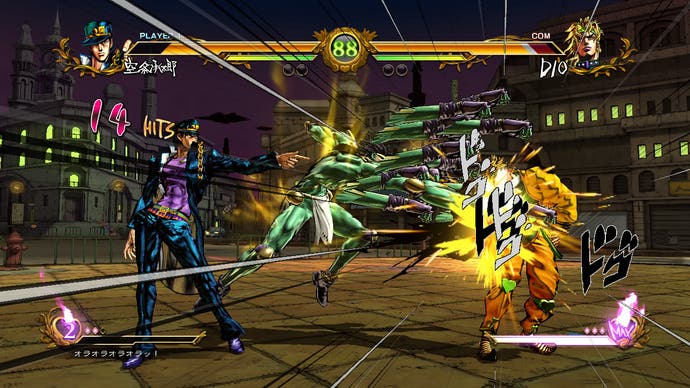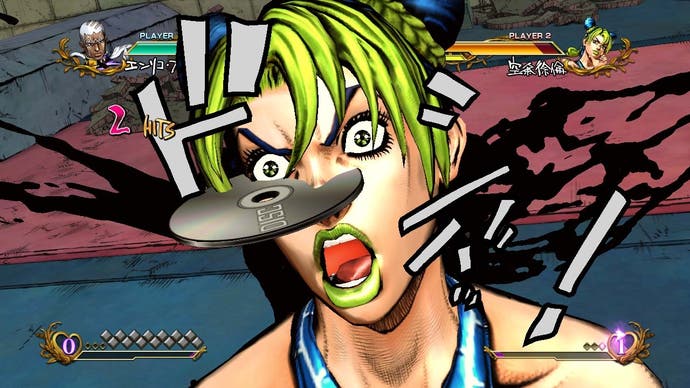JoJo's Bizarre Adventure: All-Star Battle review
Fist of the Joestar.
When you think of arcade-style fighting games, what's the first country that comes to mind? There's an argument for the macabre brutality of Mortal Kombat and the superhero antics of Injustice, but for the most part, fighting games are as Japanese as samurai swords, punctual trains and instant ramen. It therefore stands to reason that the Japanese gaming media will be pretty strict on what separates a good fighting game from a truly exceptional one, right? Well, if JoJo's Bizarre Adventure: All-Star Battle is anything to go by, maybe not.
When All-Star Battle made its Japanese debut back in 2013, Famitsu gave the game a perfect score. This is the 21st time the publication has awarded full marks in its 28-year history. The only other fighting games to achieve this are the original Soul Calibur and Super Smash Bros Brawl. Now, it's generally accepted that Famitsu isn't beholden to the same reviewing principles as its western contemporaries, but when a fighting game scores 40 out of 40, the temptation is to read it as a sign of something genuinely special rather than a systematic approval of the manga it's based upon.
For those not in the know, Jojo's Bizzare Adventure is an ongoing manga series that made its Japanese debut back in 1986. Its story centres on special individuals who fight with supernatural guardians named "Stands", and while its generation-spanning story arcs have less of a western following than the likes of Dragon Ball Z and Naruto, it remains one of Japan's best-selling series. As such, playing a Jojo's fighter with only a fleeting understanding of its extensive lore is a bit like experiencing a Batman game having never seen the films or read the comics. With no prior expectations, there's little standing between you and the raw mechanics.

The good news is that All-Star Battle comes from a solid pedigree. CyberConnect2 has always done a respectable job with the Ultimate Ninja series, and in switching to a more focused style of 2D fighting with All-Star Battle, the team has crafted a set of systems that feel immediately at home on an arcade stick. That's not to say the game can't be played competently on a pad - the BlazBlue-style Easy Beat system means that anyone can mash the light attack button for a basic combo - but if you want to explore the depths of the combat system, precise inputs are a must.
For the most part, All-Star Battle follows 2D tradition. Special moves are performed with circular motions; the three attack buttons can be chained upwards from light to heavy; supers drain a stock (or two) from your three-tiered Heart Heat Gauge; and guard breaks occur when you block too much. You also have access to more advanced systems in the Flash Cancel and Stylish Move. The former lets you cancel out of most attack animations and is principally used as a combo extender, while the latter functions similarly to Garou's classic Just Defend system. Block just before an attack connects and you'll sidestep to safety.
As familiar as the basics are, All-Star Battle is far from streamlined. The dodge button lets you hop sideways to evade a poorly timed attack, and in a nod to Injustice, each stage features an environmental hazard. These range from a speeding car that can be used for extra combo mileage to a falling chandelier that can force an evasive opponent to close the distance. There's even a practical application for the taunt button: it can be combined with a hard knockdown to steal a small portion of the opponent's super gauge. As far as two-finger salutes go, it's pretty satisfying to end a well-executed assault with a meaningful diss.

With such a high level of mechanical density, it's fair to say that All-Star Battle isn't going to win any awards for balancing. But with a roster of 32 highly eccentric characters that each fall under one of five distinctive fighting styles - namely Hamon, Vampirism, Mode, Stand and Mount - it's hard to be too critical when the ensuing spectacle is so stimulating.
Hamon characters can manually charge their super gauge and have access to EX-style specials. Vampirism is all about recharging health and draining metre. Mode lets you enter a powered-up state while your super gauge steadily decreases. Stand users are the most numerous personalities on the select screen and gain access to an adjusted move-set whenever they call forth their guardian angel. And last but not quite least, the two Mount characters can switch between a standing and a horseback stance. This is particularly beneficial for Johnny Joestar, given that he's paralysed from the waist down.
Test-driving the various characters will unveil a super move that speeds up the round timer, a Stand user who can transform his opponent into a human book and more than a few Kenshiro impersonations - and yet, when you look for substance beyond the central fighting system, All-Star Battle comes up disappointingly short.

The Story mode acts as a highlight reel for all the major battles that have taken place across the manga's eight chapters, but far from easing Jojo virgins into the narrative, the snippets of context that frame each fight are sporadic at best. It would be more forgivable if the fight conditions were more engaging, but regardless of whether you have to finish the opponent in less than 60 seconds or with only half your health, it rarely feels like you have to adjust your tactics. It's just a case of going through the motions until you achieve your inevitable victory.
If Story mode feels like a missed (and ultimately, flat) opportunity, then the online-only Campaign mode is more in keeping with the game's bizarre namesake. Rather than fighting other online players directly, this mode pits you against AI-controlled opponents. Beating these puppets will unlock a wide range of taunts, victory poses, win quotes, colours and alternate costumes. You can then customise your own AI avatar while periodically checking on his (or her) wins and losses. It sounds like an interesting distraction on the face of it, but the whole thing is tainted by a micro-transaction system that's designed to circumvent the waiting time between opponent searches.
CyberConnect2 has minimised the impact of this by reducing the wait from five minutes to just two, but rather than going for a half measure, it should have followed Monster Hunter Tri by removing the monetisation for western audiences. Thankfully, the more traditional Ranked and Player Matches can be enjoyed without any kind of enforced cool-down. The netcode does an adequate job of keeping the lag in check - just don't expect miracles if you're trading punches with someone in a radically different time-zone.

Localising a Jojo's game for the west was always going to be a bit of a hard sell, especially when it takes the form of a fairly complex fighting game. But considering what Treasure achieved with Bleach on the DS, there's no hard-and-fast rule saying that a lack of familiarity should dull the experience. Put it this way: if you played though Arkham Asylum without the foggiest idea of who the Caped Crusader was, would you still have enjoyed it? When applied to Jojo's, the answer to this question reinforces why All-Star Battle is far from flawless.
The game clearly holds a lot of reverence for its subject matter, and if you happen to be a Jojo's fan, the level of detail that's gone into each cel-shaded character model and attack animation will almost certainly get your nostalgia senses tingling. But if you approach All-Star Battle as a fighting game first and foremost, you'll discover a satisfyingly complex combat system with a few lacklustre modes. Not a 10, then, but this Jo is far from average.

